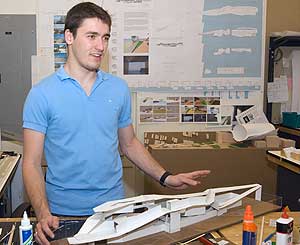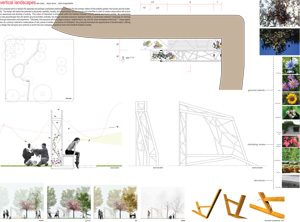Like any good architect, Taylor Dover begins each project by investigating the needs of his clients. In this case, butterflies.
With classmates Alen Basic and Adria Longenderfer, Dover — who receives a bachelor’s degree in architecture May 15 — spent much of the spring designing a combined bench and shade pavilion for the University’s Elizabeth Gray Danforth Butterfly Garden.

Part of a seminar on architecture and ecology, the group researched diets, habitats and life cycles before conceiving an intricate, ribbon-like trellis covered with flowers and climbing vines.
“A lot of butterflies live just six or eight inches off the ground,” Dover says. But the bench’s “vertical landscape” would allow low-flying lepidopterans to rise higher into the air while also providing human visitors greater opportunity for observation and learning. In other words, “there’s an environment for the butterfly and an environment for the person,” Dover says.
Though small in scale, the bench underscores something of a conceptual shift within the green- building movement. “Right now, ‘sustainable’ often means making buildings ‘less bad,'” Dover says. “But the real question is, how do we make a building that’s actually good for its environment?”
Such balance comes naturally to Dover, who grew up in rural South Carolina (near the town of Pickens) but was interested in architecture from an early age.
“My parents would buy Lego sets, and I would throw away the directions,” he says. In high school, he studied classical architecture and investigated the “Golden Ratio,” but later was captivated by Daniel Libeskind’s plans for the former World Trade Center site.
| Sam Fox School of Design & Visual Arts, College of Architecture |
At WUSTL, several of Dover’s projects have explored ideas for rebuilding urban environments. These range from St. Louis’ Bohemian Hill and Gateway Arch grounds, both cut off from downtown by tangles of converging highways, to a particularly canyon-like stretch of Interstate 70 in Kansas City.
Yet Dover has maintained his interest in the classical world, spending a semester abroad in Florence, Italy. And he has taken an active role in student government, serving as secretary and later president of the Architecture Students Council, and on the Sam Fox School’s curriculum committee.
“Taylor was a very engaged student leader,” says Bruce Lindsey, dean and the E. Desmond Lee Professor for Community Collaboration. “He saw it as an important service to both the school and his colleagues, and I think he approaches design in a similar way. He understands that in architecture, collaboration — far from diminishing personal creativity — challenges you and opens you up to new ideas.”
This semester, as part of an independent study project, Dover and seniors Lauren Ricks and Jessica Rossi-Mastracci spent months designing an entry for the Miami 2009 Pier Museum Urban Design Competition. Sponsored by Arquitectum, the competition proposes creating a 2,000-square-meter “horizontal monument” to the immigrant experience.
“It’s a very constricted space,” Dover says. The site, which would jut into the ocean from the end of Fifth Avenue in South Beach, “is 100 meters long but just 10 meters wide. The problem is to allow circulation without making the building all hallway.”
The group’s solution was a series of long, looping pathways that weave back and forth across the pier, pulling visitors through commemorative exhibitions while continually refocusing views outward to the sea and its far horizon.
“The walk becomes a memorial to the journey of Latin-American immigrants to Miami,” Dover says. (Winners will be announced later this month; first prize includes an exhibition at the University of Miami.)
Meanwhile, the butterfly bench recently won funding from the Butterfly Garden Committee and the College of Architecture. After graduation, Dover will remain in St. Louis for several weeks to complete construction before decamping for Harvard’s Graduate School of Design, where he begins classes this fall.
“I’m very interested in this idea of an ecological approach to architecture,” Dover says. “And the idea of research-based design — where perhaps you study butterflies for a few weeks before starting to build anything — really appeals to me.
“There should be an interplay between ecological systems and the systems of human life.”
